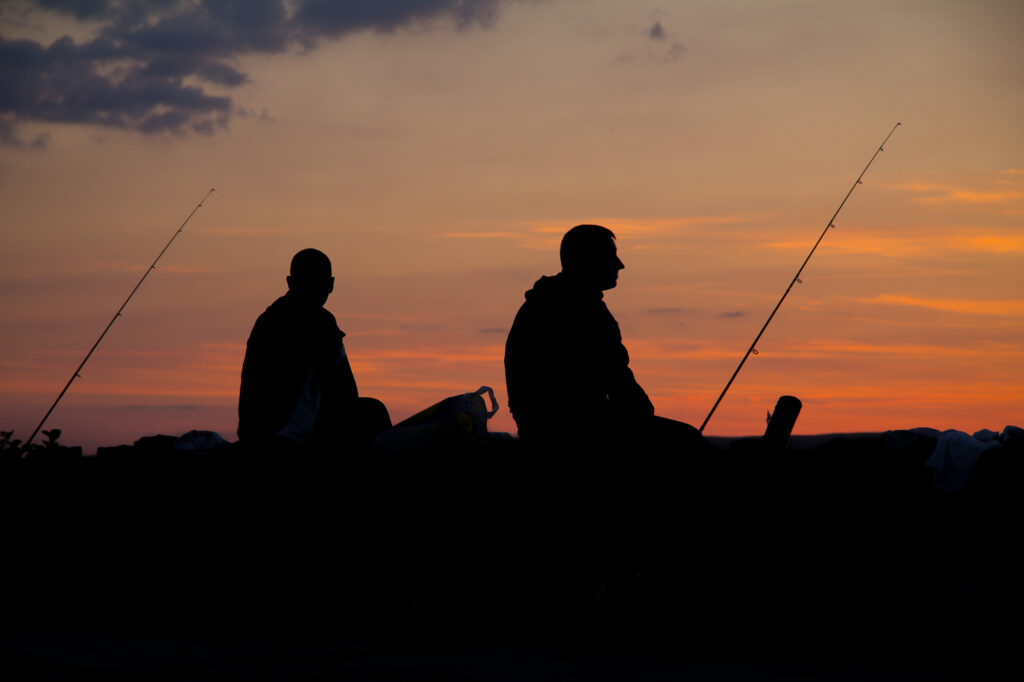
As we move into September the color palette of salmon fades from pink to silver. Millions of pink salmon generated plenty of smiles on anglers’ faces this summer, and now coho salmon—commonly referred to as silvers for their shiny silvery-colored body—are starting to arrive in the Strait of Juan de Fuca and Puget Sound.
While not large, silvers usually average 4 to 15 pounds, with some hitting the 20-plus pound mark, and they’re highly regarded for leaping and zipping across the water, making them an exciting fish to catch. Puget Sound coho returns began making a comeback a few years ago after a downtrend due to drought issues and low survival rates in 2015 and 2016. The combined 2023 Puget Sound hatchery and wild coho forecast is 760,029, up from 666,317 in 2022; 614,948 in 2021; and 504,604 in 2020.
A good sign earlier this summer was a decent number of resident coho caught in central Puget Sound (Marine Area 10) from early June into early August. Some of these coho have grown since then and will link with their migratory relatives during the fall marine fisheries. Another key indicator of when they’ll arrive in Puget Sound is to keep tabs on catch rates in the Strait of Juan de Fuca at Sekiu (Marine Area 5) to Port Angeles (Marine Area 6). Both locations are open daily through September 30 for hatchery-marked coho with a two-fish daily limit, and all coho are allowed to be retained from October 1-15. There is also a Dungeness Bay hatchery-marked coho fishery from October 1-31. The best coho action normally occurs in the shipping lanes of the Strait of Juan de Fuca; look for schools of coho jumping on the surface.
Make plans to head to the San Juan Islands (Marine Area 7) when it opens September 1-30 with a two salmon daily limit and one coho may be retained (release all Chinook and chum). The northeastern region of Whidbey Island (Marine Area 8-1) is open through September 30 for coho with a two salmon daily limit (release all Chinook and chum) from the West Point to Reservation Head eastward through Deception Pass, including all waters of Swinomish Slough and Skagit Bay, and the portion of Saratoga Passage north and west of a line from East Point light to the light on Camano Island. In 2022, anglers were limited to fishing just the bottom half along the southeastern side of Whidbey Island (Marine Area 8-2) but this season the entire area is open through September 24 with a two salmon daily limit and only one coho may be retained (release all Chinook and chum). Marine Area 8-2 is a popular location for coho and should provide very good action.
Northern Puget Sound (Marine Area 9) is open for hatchery-marked coho only now through September 17 and then switches to all coho may be retained from September 18-30. Central Puget Sound (Marine Area 10) is open for all coho now through October 31 with a two salmon daily limit (release Chinook and chum September 1-30 and release Chinook October 1-31). Target coho from Port Townsend to Marrowstone Island; Bush Point and Lagoon Point off the west side of Whidbey Island; Possession Bar; Point No Point; Pilot Point; Browns Bay; Edmonds Marina south to Richmond Beach; Kingston to Jefferson Head; Meadow Point to West Point near Shilshole Bay; and Alki Point in West Seattle south to northern tip of Vashon Island.
South central Puget Sound (Area 11) in the Tacoma-Vashon Island region will reopen September 1 for pink and coho only (daily limit of two). Starting October 1, the fishery will transition to coho and chum only. Southern Puget Sound (Area 13) is open for hatchery-marked coho and look for some good catches from the Narrows Bridge south to Anderson Island, and around the Squaxin Island net pens where the forecast is 45,417 coho (down slightly from 51,433 in 2022).
Along the coast, trek to Grays Harbor (Marine Area 2-2) for a salmon fishery east of the Buoy 13 line which is broken into two seasons. The “Humptulips North Bay” —north of a line running from the south end of the eastern jetty at the Ocean Shores Marina east to the Brackenridge Bluff Tripod—is open daily through September 15 with a one salmon daily limit and release wild Chinook and wild coho. The “East Grays Harbor Fishery” is open September 16 through November 30 with a two salmon daily limit and release all Chinook. WDFW is forecasting a relatively decent Grays Harbor basin coho return of 214,271 in 2023 up from 198,719 in 2022 and 76,518 in 2021. This forecast is based on ocean abundance of three-year-old adult fish prior to the start of any fisheries.
Another fun coho-only fishery open daily through January 31 is the Westport Boat Basin. The best action occurs from September through October as coho raised in the marina’s hatchery net pens begin to return. The daily limit is six salmon, and no more than four may be adult fish. Release Chinook, no night fishing, and an anti-snagging rule is in effect. Only single barbless hooks may be used.
South of Grays Harbor is the Willapa Bay (Marine Area 2-1) salmon fishery. The Chinook forecast is 30,320 (33,142 in 2022) and the coho forecast is 153,617 (110,483 in 2022). Fishing can be good at times, and it is open daily through Jan. 31 (although fishing wanes well before then and peaks in early- to mid-September). Most of the action in Willapa Bay happens between Channel Markers 13 and 19 on an incoming tide. The daily limit is six salmon and up to two adult salmon may be retained (release wild Chinook).